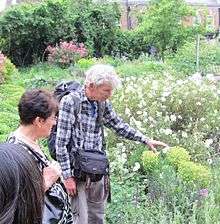St Mungo's (charity)
| Abbreviation | St Mungo's |
|---|---|
| Type | Registered charity |
| Purpose | Supporting homeless people |
| Headquarters | 3 Thomas More Square, Tower Hill, London E1W 1YW |
Region served | Southern England |
| Website | mungos.org |

The St Mungo Community Housing Association, working as St Mungo's, is a charity registered in England[2] to help homeless people.
Soup run
At the beginning St.Mungo's Community was a splinter group from The Simon Community which was started by a former probation officer Anton Wallich-Clifford and was unique among organisations for its success in alcoholic recoveries. This was essentially due to its controversial approach of allowing drinking actually on the premises. The lease for the East End shelter in Sclater street was ending and it was at a time when shortage of money drove the Simon Community into constant reorganisation. However, due to the good services of an M P James Allason, the chairman of the East End house managed to break through the almost impenetrable bureaucracy that surrounded the London County Council. Unaware that it was for a new charity they offered the short lease on a house in Home Road, Wandsworth, which was due to be demolished in two years time. It was unfortunate that once it was realised that St.Mungos was not yet even registered as a charity the young employee who completed the actual arrangement was sacked. Harry Stone had a choice of two people for the job of warden, one was the current warden of the closing Simon wet house the other a young ambitious worker at the Simon headquarters. The current warden was a reformed alcoholic and it was therefore felt he might not be able to withstand the considerable pressure he would almost certainly be under. So it was a fortunate gamble that Jim Horne was chosen. Jim was already acquainted with Geoffrey Fernyhough who had been managing director of the Green Line coaches and he agreed to become the new Chairman while Harry Stone became secretary. treasurer. and fund raiser. Jim ridiculed the suggestion the enterprise should be called The Home Road Hostel and pressed for the name St.Mungo’s. Being Scottish, he believed the powers of Glasgow Cathedral might be persuaded to make an ample donation if it was named after their patron saint. Unfortunately it proved to be a false hope. But otherwise Jim’s enthusiasm and ability drove St. Mungo to a sure start and onwards with ever increasing success. Among his early helpers was Graham Parr who in turn broke away to start up the original Vauxhall Broadway hostel. Due to the enlightened support of Wandsworth Council, even though they had never been officially informed of the occupation in Home Road, the Mayor opened the second house, which was also in Home Road.
It was not long before St. Mungos gained the interest of the Department of Health and Social Services and Jim inveigled the Head of the Department and even the Minister Sir Keith Joseph to spend an evening on the soup run. Even so it was a surprise when the department suddenly offered major financial support so that the Community could become an experimental embryo for further possible development. The amateur management had up to that time worked along unconventional lines. The Trustees had given Jim considerable licence over some of his machinations. So it had to be completely reorganised. Qualified accountants, medical practitioners and psychiatrists were appointed as additional trustees. Out of this it soon became clear that whenever either of the original Trustees held opposing views or questioned Jim’s dealings, the new Trustees, quite correctly, backed Jim since he had the responsibility for the daily running.
In the late 1960s, it faltered. Its management started cutting back and so, in May 1969, its soup run was to be ended.[3] The soup run was a nightly distribution of soup in six locations in London's West End where homeless rough sleepers or "dossers" gathered. This was provided by Wandsworth Council for a nominal rent and in 1970, the council provided three more houses nearby. The fourth house was used as an office by the developing organisation.[3]
Hostels

A large hostel, accommodating up to 200 people, was started in a disused Marmite factory in Vauxhall in 1973.[4][5] This large building, on the corner of Kennington Lane and Durham Street, had previously been notorious for the disgusting smell of the production process.[6] In the same year, another large hostel was opened in central London. This building, in Suffolk Street, had formerly been the Charing Cross Hospital. The hospital had been relocated to Fulham and Jim Horne negotiated cheap terms for occupation of the old building with the Greater London Council.[7]
There was a schism in the organisation in 1979. Jim Horne left and the organisation split into three. The Charing Cross hostel became the flagship of a new company — St Mungo's Community Housing Association. The Marmite factory hostel became the foundation of another new trust — Bondway Shelter — which then became a housing association too. The original St Mungo's Community Trust remained to focus upon the soup run but then partnered with other organisations, such as the Shepherd's Bush Housing Association, to start another hostel in Fulham. In 1980, the soup run was passed on to the Bondway organisation and the original trust went on to merge with Broadway Housing and now operates as Hestia Housing and Support. It was renamed to avoid confusion with the St Mungo's Community Housing Association, which is also now a registered charity and operates as "St Mungo's".[8]
St Mungo's is now the largest charity dealing with the homeless in London.[9] In 2010, it provided a bed for over 1500 people each night.[1] In 2011, they had over a hundred sites across southern England providing accommodation or other services to the homeless.[10]
Projects
The charity has pioneered a variety of novel programmes and initiatives.
"Bricks and Mortar" and "ReVive" training programmes
Bricks and Mortar provides the homeless with training and experience of bricklaying. ReVive is a similar scheme which develops other building skills such as plastering and decorating.[11]
"LifeWorks" project
The LifeWorks project started in 2008, providing psychodynamics psychotherapy to homeless people, especially those who are addicted to drugs or alcohol.[12]
"Putting Down Roots" project

The Putting Down Roots project enables the homeless and hostel dwellers to develop gardens and other horticultural features. It was started by Martin Snowden for St Mungo's in 2000 and has been sponsored and supported by a variety of partners. In 2012, it was still going strong with Jonathan Trustram leading the development of gardens at St John's Church, Waterloo and other places.[13][14]
Street stories
In 2009, for the 40th anniversary of the organisation, a project was started to record the oral history of the homeless. Six clients were given training in this and they then interviewed other clients, recording the history of their time on the streets and other recollections. These were then presented in an exhibition at the LSE and the results were then archived in Southwark Library.[15][16]
References
- 1 2 Sean Coughlan (17 June 2010), Homeless but not hopeless, BBC News
- ↑ Charity Commission. St Mungo's (charity), registered charity no. 1149085.
- 1 2 John Leach, John Kenneth Wing (1980), "The origins and growth of the St Mungo Community 1969-71", Helping Destitute Men, Taylor & Francis, pp. 20–23, ISBN 9780422767606
- ↑ Christopher Holmes (2005), A New Vision for Housing, p. 63, ISBN 1134236360,
Jim Home founded St Mungo's, a hostel in a former Marmite factory in south London...
- ↑ Timothy Cook (1979), Vagrancy: some new perspectives, p. 57,
In December 1973, this shelter was supplemented by a much larger building, an old Marmite factory in the south London district ...
- ↑ Marmite factory, The Vauxhall Society, 19 February 2012
- ↑ Anne Donaldson (May 6, 1978), "Homeless Scots find refuge at Jim's classy hostel", Glasgow Herald
- ↑ 40 year history (PDF), Hestia Housing and Support
- ↑ DWP's Commissioning Strategy and the Flexible New Deal, House of Commons Work and Pensions Committee, 2009, p. 161, ISBN 021552893X,
St Mungo's is the main provider of services for London's rough sleepers.
- ↑ Anna Tims (7 December 2011), "Charities for Christmas #5: St Mungo's", The Guardian
- ↑ Bruce Thain (12 April 2013), "Homeless charity St Mungo’s work programme helps renovate house in Bounds Green", Enfield Independent
- ↑ Ann Taylor (21 August 2009), St Mungo's LifeWorks psychotherapy scheme, Community Care
- ↑ Francine Raymond (28 Oct 2012), "Gardening Against the Odds 2012", The Daily Telegraph
- ↑ Rae Spencer-Jones (22 Mar 2003), "Putting down roots for a brighter future", The Daily Telegraph
- ↑ "Current British Work", Oral History, Oral History Society, 37 (2): 15, 2009, JSTOR 40650286
- ↑ "Street Stories – St Mungo's Oral History Exhibition", Time Out, 11 October 2012
External links
- "Our history of helping homeless people", a history of the current St Mungo's
- 40 year history History of Hestia, the original St Mungo's Community Trust
- A history of Thames Reach and homelessness in London, the successor to the Bondway spin-off
- About the Simon community, which started the original soup run and has now restarted such outreach projects